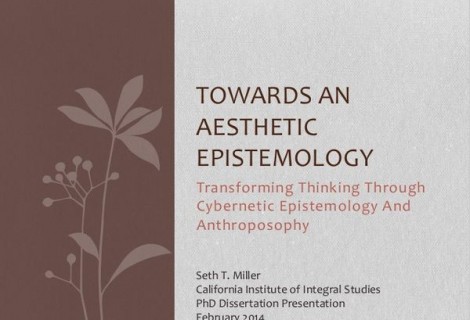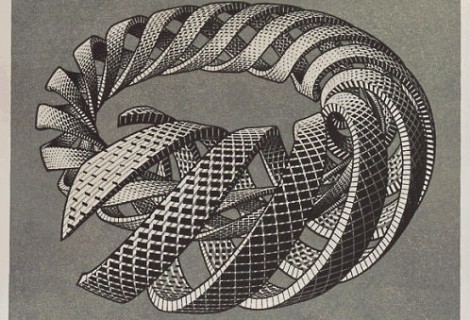Patterns in Process: Transdisciplinarity as a Background for Working with the Elemental Cycle of Transformation
« Previous Page | 1 2 3 4 5 6 7 | View All | Next Page »
 Abstract
Abstract
This essay outlines connections between the Elemental Cycle as an archetype of transformation, transdisciplinarity, and cybernetics. A number of questions are addressed: the nature and importance of connecting these fields, an examination of resources and the dominant disciplinary discourses for the associated fields, and a critical examination of my assumptions, beliefs, and position.
Introduction
How often do we find ourselves in a position of not being able to see something unless it is first pointed out to us? This happens all the time with the visual and other physical senses, but of course also occurs in our thinking; certain concepts seem to hide in plain sight, and unless we are cued into where and how to look for (or to think about) them, they slide on by as a part of the undifferentiated background of conceptual life. Usually we are introduced to these sorts of concepts just like we are to new people, through a third party who is already familiar with each of us: “Seth, I’d like you to meet Recursion; Recursion, this is Seth.” Often with this sort of introduction comes an experience: “Oh hello Recursion! You know, I feel like you must hang out at some of the same coffee-shops as I do, but we’ve never been formally introduced.” And so a relationship begins with a concept, and just as with human beings, you can become more intimate and familiar, get into fights, seek new levels of understanding, and go on adventures.
I was introduced to the Elemental Cycle over 10 years ago: an archetypal pattern of the process of transformation, situated in the four alchemical elements of Earth, Water, Air, and Fire, and we have been journeying together ever since. This pattern seemed like the kind of concept (although archetypes are much more than merely conceptual) that Goethe called an “open secret”—invisible to cursory examination, but completely out in the open and obvious once you know how to recognize it, and have some familiarity with its style.
Phrased more simply, the Elemental Cycle concerns how transformation occurs. What I’m interested in is the extent to which there are lawful patterns that describe how transformation really happens in the world, both in personal experience of one’s own transformation and as a way of describing more ‘objective’ processes that do not explicitly have to do with humans. Are there patterns to transformation, or does transformation occur through a wide variety of processes which have little or no relationship to each other? How do we know that transformation is occurring, or has occurred?
My feeling about this can be made clear through a metaphor. There are many paths up a mountain, and if you ask each person to describe the specific details that they observed on their way, you’ll get a unique description from each person. This is complicated by the fact that even if two people travel the very same path, they will likely pay attention to different features and give diverse accounts. Nevertheless, with some probing you can find certain aspects which begin to coincide and link from story to story; for example, the fact that no matter what path you take, an overall directionality is apparent: from low to high elevation. Other patterns exist, but this serves to illustrate the point that even though “transformation” can happen in an extremely wide variety of contexts and through a number of seemingly diverse processes, it is my understanding that certain patterns continually inform how transformation unfolds. In particular, my research has brought me to an understanding of some of these patterns, which, borrowing from the language and tradition of alchemy (where everything is about transformation) I call Earth, Water, Air and Fire. These four elements are manifestations of the archetype of the pattern of transformation. Each element describes one qualitative stage of the process through which any transforming situation unfolds, and they fit together in a cycle (or rather, a vortex, which is always a spiral), moving from an initial (often unconscious) Fire, onwards to Earth to Water to Air, then to Fire again, and back to what we could call a New Earth. The details of each elemental stage and the building up of the underlying theory constituted the subject of my master’s thesis.
Future inquiry needs to explore more fully the application of this archetypal metaphor to human transformation. Central to this inquiry is simply the desire to become more familiar and fluent with how the pattern works, where it works (and where it doesn’t), and the extent to which consciousness of the pattern can be of practical help in regards to work that attempts to bring about, make efficient, or to simply understand transformative processes. The Elemental Cycle has clear potential applications in therapy, counseling, spiritual practice, dialogue and communication, planning, management, education, personal growth, and scientific realms; as an archetype it necessarily crosses boundaries such as these with ease. The linking factors between all these areas are processes in human consciousness. As there is almost no published literature that deals with this particular way of dealing with the elements and transformation, my work will be primarily to remedy this gap, and to make the strongest case for the applicability of the Elemental Cycle through specific examination of transformative situations.
I believe this work is important for a number of reasons. My experience with the Elemental Cycle has shown me that it can be a reliable guide for the deepening of consciousness around transformative processes. It helps clarify and complexify understanding, it responds flexibly to a variety of situations and can be applied across scales, and it actively helps lead one through transformations by providing contact with and context within an archetypal, lawful, process that transcends the potentially limiting and blinding nature of personal (subjective) patterns of thinking, feeling, and behaving. This kind of understanding and approach to transformation, which has transpersonal roots and implications, and which builds on a view of the human being and cosmos that is normally ignored by the majority of academic discourse (as it lies outside any academic discipline), is simply missing in the literature. By studying the application of the Elemental Cycle, and framing it through the more modern languages of transdisciplinarity, complexity theory, cybernetics, and general systems theory, I hope to provide a strong foundation for its theoretical basis and practical potential. Ultimately, I aim at bringing to a larger audience an entryway into a different way of thinking and perceiving, which can adaptively move between self and other, operates fluidly on multiple levels, includes the full complexity of the human being, and which recognizes and employs the transpersonal. This way of thinking is compatible with the three principles underlying the paradigm of complexity laid out by Edgar Morin (2008): 1) the dialogic, which “allows us to maintain duality at the heart of unity, [associating] two terms that are at the same time complementary and antagonistic” (Morin, 2008, p. 49), 2) organizational recursion, where “the products and the effects are at the same time causes and producers of what produces them” (Morin, 2008, p. 49), and 3) the holographic principle, where “the part [is] in the whole, [and] the whole is in the part” (Morin, 2008, p. 50).
This inquiry has always presented me with a number of difficulties (but many more successes and insights). First of all, what I’m after is very, very difficult to work with directly, because of its intrinsically wily nature. Archetypes cannot be pinned down and captured like a butterfly on an etymologist’s display board. You can’t even capture transformation by pinning down each successive stage of the caterpillar-to-butterfly process; you only end up with the death of the very thing under scrutiny (this is a manifestation of an Earth-type approach to transformation). Working with an archetype–particularly an archetype of transformation–requires a different way of working. (A treatment of what I mean by the word archetype follows the discussion of Jung below.)
Transdisciplinarity
Transdisciplinarity, luckily, has run into and attempted to deal with many of the very same problems that I face in my inquiry. Basarab Nicolescu, one of the founders of transdisciplinarity, points out that disciplinary processes of knowledge creation—the dominant mode through which most knowledge in the Western world has been constructed for the past few centuries—is only one arrow shot from the bow of knowledge (Nicolescu, 2008, p. 3), the others are multi-disciplinarity, inter-disciplinarity, and finally transdisciplinarity. Disciplines have a tendency to form specialized knowledge on the basis of assumptions and methodologies which are unique to the individual discipline. Indeed, many disciplines are initially formed in and by the very process of distinguishing themselves from other disciplines in just this way. While allowing for extremely specialized forms of knowledge, such disciplinarity can lead practitioners into the situation, described by Brue Wilshire (1990), in which “missing is any sense that anything is missing” (Wilshire, 1990, p. 12).
Disciplines keep their purity by engaging in what Wilshire calls veiled purification rituals: “the refusal to mix a stance with other views (and evidence) which are palpably relevant to it. Mary Daly calls it methodolotry. Each field’s formalism defines and guards its boundaries” (Wilshire, 1990, p. 161). Lewis Gordon (2006) identifies a similar pattern:
The emergence of disciplines has often led to the forgetting of their impetus in living human subjects and their crucial role in both the maintenance and transformation of knowledge-producing practices. The results are special kinds of decadence. One such kind is disciplinary decadence. Disciplinary decadence is the ontologizing or reification of a discipline.” (Gordon, 2006, p. 4)
« Previous Page | 1 2 3 4 5 6 7 | View All | Next Page »





